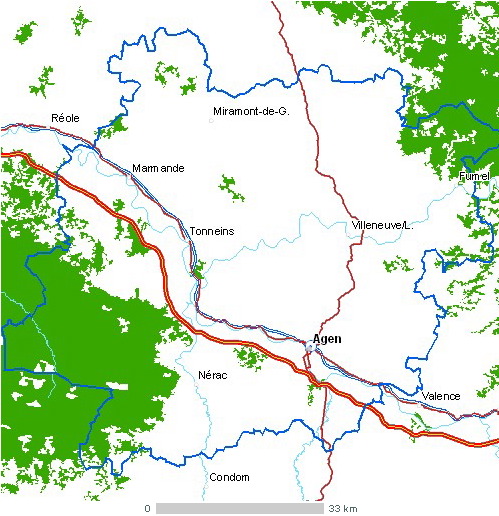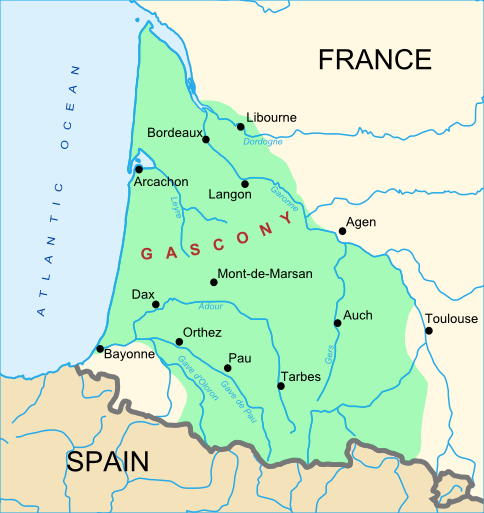|
Bouchalès
Bouchalès or Grapput is a red French wine grape variety that is grown primarily in Bordeaux and Southwest France wine appellations. Plantings have declined in recent years as the vine has shown high sensitivity to downy mildew and black rot.J. Robinson ''Vines, Grapes & Wines'' pg 204 Mitchell Beazley 1986 Old vine plantings of Bouchalès that more than a 100 years exist at Château de la Vieille-Chapelle in the Fronsac AOC located just northwest of the city of Libourne in the "Right Bank" region of Bordeaux. These vines are believed to be some of the oldest vines in Bordeaux (where only 27% of the vines average more than 30 years age Wine Mega Bordeaux: A Few Statistical Figures'' Bordeaux News, January 2004), having likely survived the phylloxera epidemic of the late 19th century due to the ancient Libournais practice of flooding the vineyards in winter which would disrupt the nymph stage in the life cycle of phylloxera.J. Robinson, J. Harding and J. Vouillamoz ''Wine Gr ... [...More Info...] [...Related Items...] OR: [Wikipedia] [Google] [Baidu] |
Grape Variety
This list of grape varieties includes cultivated grapes, whether used for wine, or eating as a table grape, fresh or dried (raisin, currant, sultana). For a complete list of all grape species including those unimportant to agriculture, see Vitis. The term ''grape variety'' refers to cultivars rather than actual botanical varieties according to the International Code of Nomenclature for Cultivated Plants, because they are propagated by cuttings and may have unstable reproductive properties. However, the term ''variety'' has become so entrenched in viticulture that any change to using the term ''cultivar'' instead is unlikely. Single species grapes While some of the grapes in this list are hybrids, they are hybridized within a single species. For those grapes hybridized across species, known as interspecific hybrids, see the section on multispecies hybrid grapes below. ''Vitis vinifera'' (wine) Red grapes White grapes Rose Grapes ''Vitis vinifera'' (table) ... [...More Info...] [...Related Items...] OR: [Wikipedia] [Google] [Baidu] |
Southwest France Wine
South West France, or in French ''Sud-Ouest'', is a wine region in France covering several wine-producing areas situated respectively inland from, and south of, the wine region of Bordeaux. accessed on February 23, 2008 These areas, which have a total of 16,000 s (40,000 acres) of vineyards, consist of several discontinuous wine "islands" throughout the region (where Bordeaux region itself is situated), and more or less to the west of the |
French Wine
French wine is produced all throughout France, in quantities between 50 and 60 million hectolitres per year, or 7–8 billion bottles. France is one of the largest wine producers in the world, along with Italian, Spanish, and American wine-producing regions. French wine traces its history to the 6th century BCE, with many of France's regions dating their wine-making history to Roman times. The wines produced range from expensive wines sold internationally to modest wines usually only seen within France such as the Margnat wines of the post war period. Two concepts central to the better French wines are the notion of ''terroir'', which links the style of the wines to the locations where the grapes are grown and the wine is made, and the ''Appellation d'origine contrôlée'' (AOC) system, replaced by the Appellation d'Origine Protégée (AOP) system in 2012. Appellation rules closely define which grape varieties and winemaking practices are approved for classification ... [...More Info...] [...Related Items...] OR: [Wikipedia] [Google] [Baidu] |
Dordogne
Dordogne ( , or ; ; oc, Dordonha ) is a large rural department in Southwestern France, with its prefecture in Périgueux. Located in the Nouvelle-Aquitaine region roughly half-way between the Loire Valley and the Pyrenees, it is named after the river Dordogne, which runs through it. It corresponds roughly to the ancient county of Périgord. In January 2019, Dordogne had a population of 413,223. History The county of Périgord dates back to when the area was inhabited by the Gauls. It was originally home to four tribes. The name for "four tribes" in the Gaulish language was "Petrocore". The area eventually became known as the county of Le Périgord and its inhabitants became known as the Périgordins (or Périgourdins). There are four Périgords in thDordogne * The "Périgord Vert" (Green Périgord), with its main town of Nontron, consists of verdant valleys in a region crossed by many rivers and streams;. * The "Périgord Blanc" (White Périgord), situated around the dep ... [...More Info...] [...Related Items...] OR: [Wikipedia] [Google] [Baidu] |
Gers
Gers (; oc, Gers or , ) is a department in the region of Occitania, Southwestern France. Named after the Gers River, its inhabitants are called the ''Gersois'' and ''Gersoises'' in French. In 2019, it had a population of 191,377.Populations légales 2019: 32 Gers INSEE History In the , the was nearby. Gers is one of the original 83 departments created during the |
Lot-et-Garonne
Lot-et-Garonne (, oc, Òlt e Garona) is a department in the Nouvelle-Aquitaine region of Southwestern France. Named after the rivers Lot and Garonne, it had a population of 331,271 in 2019.Populations légales 2019: 47 Lot-et-Garonne INSEE Its and largest city is . History Lot-et-Garonne is one of the original 83 departments created on 4 March 1790, as a result of the ...[...More Info...] [...Related Items...] OR: [Wikipedia] [Google] [Baidu] |
DNA Testing
Genetic testing, also known as DNA testing, is used to identify changes in DNA sequence or chromosome structure. Genetic testing can also include measuring the results of genetic changes, such as RNA analysis as an output of gene expression, or through biochemical analysis to measure specific protein output. In a medical setting, genetic testing can be used to diagnose or rule out suspected genetic disorders, predict risks for specific conditions, or gain information that can be used to customize medical treatments based on an individual's genetic makeup. Genetic testing can also be used to determine biological relatives, such as a child's biological parentage (genetic mother and father) through DNA paternity testing, or be used to broadly predict an individual's ancestry. Genetic testing of plants and animals can be used for similar reasons as in humans (e.g. to assess relatedness/ancestry or predict/diagnose genetic disorders), to gain information used for selective breeding, o ... [...More Info...] [...Related Items...] OR: [Wikipedia] [Google] [Baidu] |
Pacherenc Du Vic-Bilh
Madiran wine is produced around the village of Madiran in Gascony under three '' Appellations d'Origine Contrôlées'' (AOCs): Madiran for red wines and Pacherenc du Vic-Bilh and Pacherenc du Vic-Bilh Sec for white wines. The production area for Madiran wine is spread over three '' départments'' – Gers, Hautes-Pyrénées and Pyrénées-Atlantiques – and is a part of the South West France wine region. There are of Madiran vineyards.CIVSO: AOC MADIRAN carte d'identité accessed on May 17, 2008 Madiran AOC Madiran was created as an AOC in 1948, and only red wine can be produced under this appellation. The main grape variety in Madiran AOC is Tannat[...More Info...] [...Related Items...] OR: [Wikipedia] [Google] [Baidu] |
Arrufiac
Arrufiac (or Arrufiat) is a white French wine grape varietyArrufiac , accessed on June 26, 2010 that is primarily planted in the region of South West France. It is a secondary grape in the wines from the '' |
Color Mutation
The propagation of grapevines is an important consideration in commercial viticulture and winemaking. Grapevines, most of which belong to the ''Vitis vinifera'' family, produce one crop of fruit each growing season with a limited life span for individual vines. While some centenarian old vine examples of grape varieties exist, most grapevines are between the ages of 10 and 30 years. As vineyard owners seek to replant their vines, a number of techniques are available which may include planting a new cutting that has been selected by either clonal or mass (massal) selection. Vines can also be propagated by grafting a new plant vine upon existing rootstock or by layering one of the canes of an existing vine into the ground next to the vine and severing the connection when the new vine develops its own root system.Wine & Spirits Education Trust ''"Wine and Spirits: Understanding Wine Quality"'' pp. 2-5, Second Revised Edition (2012), London . In commercial viticulture, grapevines are ... [...More Info...] [...Related Items...] OR: [Wikipedia] [Google] [Baidu] |
Surname
In some cultures, a surname, family name, or last name is the portion of one's personal name that indicates one's family, tribe or community. Practices vary by culture. The family name may be placed at either the start of a person's full name, as the forename, or at the end; the number of surnames given to an individual also varies. As the surname indicates genetic inheritance, all members of a family unit may have identical surnames or there may be variations; for example, a woman might marry and have a child, but later remarry and have another child by a different father, and as such both children could have different surnames. It is common to see two or more words in a surname, such as in compound surnames. Compound surnames can be composed of separate names, such as in traditional Spanish culture, they can be hyphenated together, or may contain prefixes. Using names has been documented in even the oldest historical records. Examples of surnames are documented in the 11th ... [...More Info...] [...Related Items...] OR: [Wikipedia] [Google] [Baidu] |
Grapevines
''Vitis'' (grapevine) is a genus of 79 accepted species of vining plants in the flowering plant family Vitaceae. The genus is made up of species predominantly from the Northern Hemisphere. It is economically important as the source of grapes, both for direct consumption of the fruit and for fermentation to produce wine. The study and cultivation of grapevines is called viticulture. Most cultivated ''Vitis'' varieties are wind-pollinated with hermaphroditic flowers containing both male and female reproductive structures, while wild species are dieceous. These flowers are grouped in bunches called inflorescences. In many species, such as ''Vitis vinifera'', each successfully pollinated flower becomes a grape berry with the inflorescence turning into a cluster of grapes. While the flowers of the grapevines are usually very small, the berries are often large and brightly colored with sweet flavors that attract birds and other animals to disperse the seeds contained within the berrie ... [...More Info...] [...Related Items...] OR: [Wikipedia] [Google] [Baidu] |








